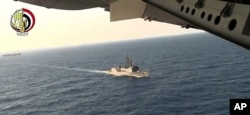Security at European airports is coming under urgent scrutiny as mystery continues to surround the cause of the EgyptAir crash. While it isn’t clear what caused Flight 804 to drop out of the sky and smash into the Mediterranean, the history of security lapses at all the airports the plane visited that day is heightening suspicions terrorism was behind the crash.
Aviation experts also note there was no distress broadcast by the pilot while the plane was twisting and veering, which is adding to the suspicions of a terrorist plot just two months after deadly attacks at Belgium’s Zaventem airport.
The Zaventem attacks were carried out on the ground, in a passenger terminal, but if Flight 804 was brought down by a bomb, aviation experts and government officials say the most likely explanation is that a device was put on board by a worker at one of the four airports the plane visited that day.
Terrorism is not the only possible cause for the crash. Aviation experts caution that a catastrophic mechanical failure or pilot error could have brought down the airliner.
While there can be no definitive explanation of what happened until the cockpit voice-recorder is recovered from the Mediterranean Sea — and that could take weeks, or even months — European security officials are not wasting time.
At Paris Charles de Gaulle airport, where the Airbus 320 took off for its final journey, security arrangements are already under review with attention being focused on the nearly 90,000 airport staff, including baggage handlers and aircraft ground crew.
The EgyptAir jet was on its fifth flight of the day. Before departing for Cairo, it had already flown from Asmara in Eritrea to Egypt and from Cairo to Tunis and back before its final, fateful takeoff from Paris. Investigators are reviewing security arrangements at the stops made by the plane in the hours before the disaster.
Aviation security analyst Chaim Koppel of International Security Defense Systems in Dallas, Texas, says nowadays it would be easier for airport employees to get a bomb on board a commercial jet than to use passengers, who go through far more stringent checks when entering departure lounges. “The most vulnerable part of our aviation security system is the screening of employees. Physical screening of employees, that’s where emphasis and money should go,” he argues.
Charles de Gaulle, the busiest airport in continental Europe, already routinely re-screens its employees. France’s transport minister, Alain Vidalies, insisted Friday that security was already tight before this week's disaster in the air.
Since January 2015, more than 60 staff have had their access to secure areas at Paris’ two main international airports revoked, because of possible “links to Islamic extremism.” The thought that Charles de Gaulle could have been the place where an explosive device was smuggled aboard a plane is a nightmare scenario for aviation experts.
Parallels are bringing drawn with last October’s downing of a Russian Metrojet Airbus by jihadists shortly after it took off from Egypt’s Sharm el-Sheikh airport, where tourists complained security was lax. The Islamic State group claimed it placed explosives disguised as a soft-drink can on the jet, and most experts believe the terrorists used ground crew to sneak the device on board.
After that attack, aviation security expert Philip Baum said, “Identifying ‘bad eggs’ is no easy task,” especially since airport employees often are “low-paid, transient workers.”
“A perfect system does not exist,” said Sylvain Prevost, trainer in air transport security for the ASTC (Aviation Security Training Center). “The question today is: if something did happen at Charles de Gaulle, then there must have been people colluding in it, because now it’s extremely difficult to penetrate airport security.”
British travel writer Simon Calder says, if it turns out that an explosive device was smuggled abioard EgyptAir's A320 Airbus in Paris, “Airline passengers' faith in global aviation would be shaken.”
Some European security officials admit privately that they are hoping, if the downing of the EgyptAir plane was caused by an act of terrorism, it involved a device smuggled on board while the airliner was at airports in North Africa or the Horn of Africa, and not Paris, an airport that is meant to be one of the most secure in the world.
That would be no consolation for the relatives of the 66 killed, nor would it lessen the security challenges facing the global aviation industry. It would mean the terrorists had confidence that a sophisticated timing mechanism could detonate explosives after multiple takeoffs and landings - in this case, after the jet's final flight toward Cairo.
Questions would turn also to how security can be improved in Africa and what new procedures should be introduced for checking passenger jets on the ground after they have flown in from other countries, European or otherwise. Flight and cabin crews are meant to check their aircraft visually between flights, but that may have to change to a system of more stringent inspections.
That would have ripple effects for airlines, especially the low-cost carriers that cut costs and fares by arranging fast airport turnarounds for their planes.










